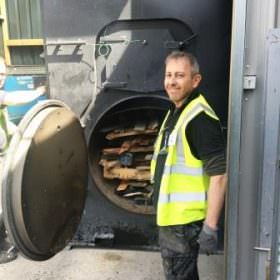Bio-mass burner solves heating problem for London Stone

We have been working with London Stone now for many years, as their preferred plumber on a whole variety of plumbing and heating projects, helping them to set up all their new showrooms, offices and factories. Recently, we were jointly faced with a new type of challenge, one that was solved in a highly efficient way, resulting in cost savings, time savings and energy savings, as well as being very good from an environmental point of view. Let’s hope this article is of interest to other pro-active companies faced with similar opportunities.
An interesting heating challenge
London Stone has an ongoing need to dry the stone they cut, prior to sealing it. For many years they have been using an adapted shipping container with a big LPG heater, which cost them a lot of money to run. They were also spending a great deal of management time and money on skips to haul away the old pallets and timber packaging used for shipping, much of which was unable to be used in an environmentally positive way and some of which ended up in landfill.
London Stone thought there must be a better way of drying the stone and, after a lot of research and shopping around, they found a company in Ireland that builds bio-mass wood burners, at which point they sought our advice on the practicalities and the installation, as this clearly required plumbing expertise. We confirmed that this was an excellent idea and together we sourced the best unit and planned how to install it most efficiently with regard to productivity, accessibility and best use of space.
The heating & plumbing solution
 We planned the project to continue to use the current shipping container, at one end of which the bio-mass wood burner was installed.
We planned the project to continue to use the current shipping container, at one end of which the bio-mass wood burner was installed.
The unit has a large furnace type chamber at the bottom, at the perfect height to load the pallets and waste timber into the burner. When the burner is on, the chamber heats the water surrounding it, which then gets pumped around a flow and return pipe system, leading to and from a huge radiator (similar to that in a car) which is sandwiched between a big ducting system, complete with fan. This was all bolted to the roof of the shipping container.
Once everything was in place, we had to plumb in all the associated pipe work, fit the secondary shunt pump and feed tank, assemble all the ducting and fan unit, and then cut a big hole in the roof of the shipping container to allow the heat produced to enter the container via the ducting.
 Due to the scale of the project, we had to use 1½” steel pipes. These pipes aren’t standard plumbing pipes such as are normally used in residential projects, rather they are designed for industrial projects, are delivered in 6m lengths and are very heavy. Each one had to be threaded and cut to exact size, using specialist cutting and threading tools. Given the weight involved, we had to design a hanging system to support the pipe clips and the pipe work.
Due to the scale of the project, we had to use 1½” steel pipes. These pipes aren’t standard plumbing pipes such as are normally used in residential projects, rather they are designed for industrial projects, are delivered in 6m lengths and are very heavy. Each one had to be threaded and cut to exact size, using specialist cutting and threading tools. Given the weight involved, we had to design a hanging system to support the pipe clips and the pipe work.
The whole project took 3 days to plan, 7 days to complete and has been immediately successful, both in terms of time and money saved and in terms of heating efficiency. A good solution all round and one that could benefit a number of businesses that have timber waste to dispose of, irrespective of how the heat generated is to be used: the heat could be used for hot water or for heating, for buildings, offices or other properties.
Environmental benefits
Another benefit of such a system is that a bio-mass boiler is generally considered a low-carbon option, as the carbon dioxide emitted when wood is burned is the same amount that was absorbed over the months and years that the tree producing the wood was growing. The process is sustainable as long as new trees are planted and grown in place of those used for fuel.
If the bio-mass burner requires wood (i.e. fuel) to operate, then there are some carbon emissions caused by the cultivation, manufacture and transportation of the wood (fuel), however, as long as the wood (fuel) is sourced locally, these are much lower than emissions from fossil fuels and in a case such as London Stone, where the fuel is on site and would indeed generate emissions to move, it becomes an even more environmentally efficient option.
For more information, feel free to email info@dpsheatingandplumbing.com
